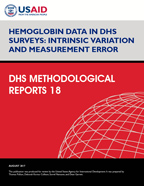
Abstract:
The accurate estimation of anemia is
important for tracking and targeting public
health interventions. The primary source of
anemia data in low and middle-income
countries is The Demographic and Health
Surveys
Program, in which hemoglobin concentration is
assessed with a portable hemoglobinometer.
This methodological report examines
measurement error of hemoglobin assessment
and the intrinsic variation in hemoglobin
concentrations among children (age 6-59
months), nonpregnant women of reproductive
age (age 15-49), and men (age 15 and above).
A total of 80 surveys in The Demographic and
Health Surveys Program conducted between 2000
and 2017 were selected, which results in a
total of 1,247,942 hemoglobin observations
included in this report (children n=405,731,
women n=607,101, men n=235,110). Data quality
was assessed by examining bias in the sub-
sampling strategy, data completeness, and
digit preference.
Dispersion of the hemoglobin concentrations
was also explored but it was difficult to
determine whether the patterns observed are
the result of measurement error or intrinsic
variations. There was little bias found in
the situations where hemoglobin measurements
were only taken on a subsample
of the population, although in a few surveys
there was a slight bias by head of household
education level, wealth, and urban/rural
residence. There were very few values outside
of the plausible ranges (mean
percent ranged from 0.1 to 0.2% depending on
the subpopulation) and only a small percent
of data was missing (mean percent ranged from
4.5 to 15%). Digit preference was found to
occur for the digits 0 (11.6%
of surveys) and 2 (10.5%), and for the
combination of digits 6, 7, 8, and 9 (22.1%).
Standard deviations were outside the range of
1.1 to 1.5 in many surveys for children
(46.3% with excluded implausible values
versus 58.8% with included implausible
values), women (70.8% with excluded
implausible values vs. 81.5% with included
implausible values), and men (96.3% with
excluded implausible values vs. 96.3% with
included implausible values). Data was not
normally distributed in many of the
surveys, especially among adults. Hemoglobin
concentrations were higher in urban regions
and wealthy populations, and in these groups
there was less data dispersion, skewness, and
kurtosis.
In conclusion, our findings indicate that the
overall quality of data is high on some
measures, although there are exceptions,
especially wide standard deviations.
Disentangling measurement error from
intrinsic
variation is difficult. Future research is
needed to establish standard parameters that
assess measurement error in the assessment of
hemoglobin and other biomarkers.
 Hemoglobin Data in DHS Surveys: Intrinsic Variation and Measurement Error (PDF, 2247K)
Hemoglobin Data in DHS Surveys: Intrinsic Variation and Measurement Error (PDF, 2247K)
